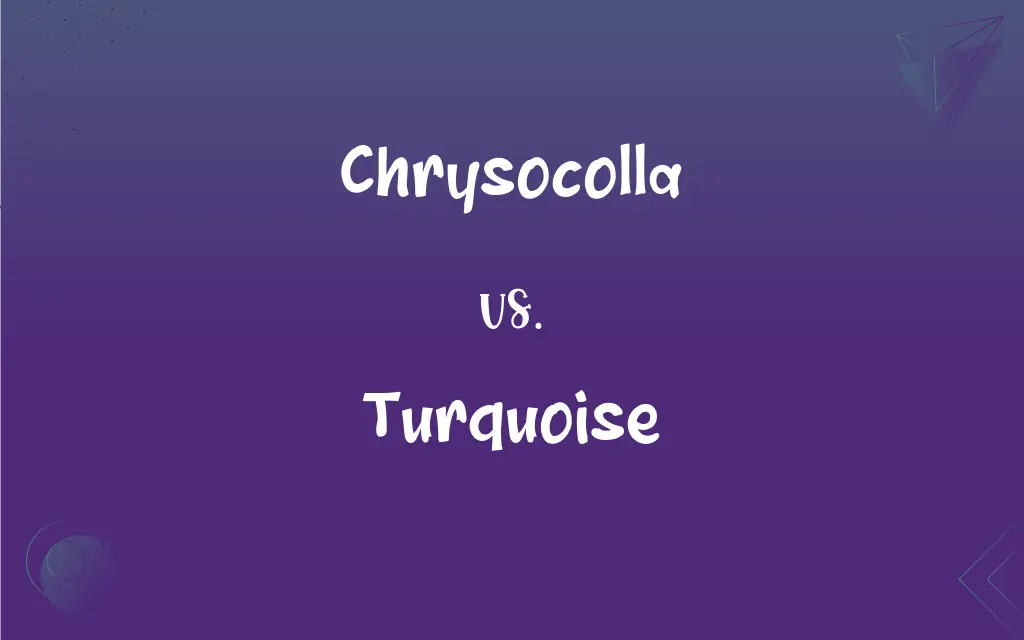Chrysocolla vs. Turquoise: What's the Difference?
Edited by Aimie Carlson || By Harlon Moss || Published on December 4, 2023
Chrysocolla is a copper silicate mineral known for its blue to green color, while turquoise is a phosphate mineral famous for its bright blue to green hues.

Key Differences
Chrysocolla is a copper silicate hydroxide mineral, displaying a range of blue to green colors and often confused with turquoise. Turquoise, however, is a copper aluminum phosphate mineral, distinct for its sky blue to green colors, with a more uniform and vivid hue compared to chrysocolla.
The composition of chrysocolla includes silica, making it softer and more fragile than turquoise. Turquoise is known for its higher hardness and durability, which makes it more suitable for use in jewelry that requires longevity and resistance to wear.
Chrysocolla often forms in the oxidation zones of copper deposits and has a glassy to dull luster. Turquoise, typically found in arid regions, has a waxy to dull luster and is often associated with copper mining areas as well.
In terms of history and usage, chrysocolla was known to the ancient Greeks and Egyptians but was not as widely used as turquoise. Turquoise has a rich history, especially in Native American and Middle Eastern cultures, where it has been highly valued for centuries.
Chrysocolla is often found mixed with other minerals, which can affect its color and appearance. Turquoise, while it may also have inclusions, is more commonly recognized for its relatively uniform color and the presence of matrix patterns, which are valued in some jewelry styles.
ADVERTISEMENT
Comparison Chart
Chemical Composition
Copper silicate hydroxide
Copper aluminum phosphate
Hardness
Softer, more fragile
Harder, more durable
Color Range
Blue to green, often with variegation
Sky blue to green, more uniform
Historical Use
Known to ancient cultures, less widespread
Extensive history, especially in Native American and Middle Eastern cultures
Common Formations
Often mixed with other minerals
Typically more uniform with possible matrix patterns
ADVERTISEMENT
Chrysocolla and Turquoise Definitions
Chrysocolla
Copper Silicate Mineral.
The chrysocolla specimen displayed a beautiful range of green and blue hues.
Turquoise
Copper Aluminum Phosphate Mineral.
The turquoise stone had a bright blue color characteristic of its composition.
Chrysocolla
Historical Gemstone.
Chrysocolla was known to the ancient Egyptians.
Turquoise
Sky Blue to Green Hues.
The turquoise's color reminded her of the sky.
Chrysocolla
Mixed Minerals.
This chrysocolla is intermingled with quartz.
Turquoise
Matrix Patterns.
This turquoise piece featured a beautiful matrix pattern.
Chrysocolla
Gemstone.
She wore a pendant made of polished chrysocolla.
Turquoise
Jewelry Stone.
His ring was adorned with a striking turquoise gem.
Chrysocolla
Color Variations.
The chrysocolla stone had a unique blend of colors.
Turquoise
Cultural Significance.
Turquoise is significant in Native American culture.
Chrysocolla
A blue to blue-green amorphous mineral, Cu2H2(Si2O5)(OH)4 often occurring as thin seams or surface layers in the oxidation zones of copper ores.
Turquoise
A blue to blue-green mineral of aluminum and copper, mainly CuAl6(PO4)4(OH)8·4H2O, prized as a gemstone in its polished blue form.
Chrysocolla
(mineral) A vitreous silicate mineral that is a minor ore of copper, with the chemical formula (Cu2+,Al)2H2Si2O5(OH)4·nH2O.
Turquoise
A light to brilliant bluish green.
Chrysocolla
A hydrous silicate of copper, occurring massive, of a blue or greenish blue color.
FAQs
How is chrysocolla used?
Primarily as a gemstone in jewelry and decorative objects.
What is the color range of chrysocolla?
It varies from blue to green, often with mixed hues.
What is chrysocolla?
A blue to green copper silicate hydroxide mineral.
How hard is chrysocolla?
It's relatively soft and can be fragile.
Is turquoise a hard mineral?
Yes, it's relatively hard and durable, suitable for jewelry.
What is turquoise?
A copper aluminum phosphate mineral with a distinctive blue-green color.
What are the uses of turquoise?
Mainly in jewelry and as a decorative and culturally significant stone.
How does the color of turquoise differ from chrysocolla?
Turquoise is typically more uniformly blue to green.
Does chrysocolla have historical significance?
Yes, it was known to ancient Greeks and Egyptians.
Where is chrysocolla commonly found?
In the oxidation zones of copper deposits.
What is unique about turquoise's appearance?
It often has matrix patterns, which are valued in some jewelry styles.
Is turquoise historically important?
Very much so, especially in Native American and Middle Eastern cultures.
Are there synthetic versions of chrysocolla?
Synthetic versions are rare; most chrysocolla on the market is natural.
Can turquoise be synthesized?
Synthetic turquoise exists, but it's distinct from natural turquoise.
Can chrysocolla be used in everyday jewelry?
Due to its softness, it's better suited for occasional wear.
What's the best way to maintain turquoise jewelry?
Keep it away from chemicals and extreme temperatures.
Does chrysocolla form with other minerals?
Yes, it's often found mixed with quartz and other minerals.
How can you tell real turquoise from fake?
Real turquoise has a unique color and matrix patterns that are hard to replicate exactly.
What is the luster of chrysocolla?
It ranges from glassy to dull.
How do you care for chrysocolla jewelry?
It should be handled gently and kept away from harsh chemicals.
About Author
Written by
Harlon MossHarlon is a seasoned quality moderator and accomplished content writer for Difference Wiki. An alumnus of the prestigious University of California, he earned his degree in Computer Science. Leveraging his academic background, Harlon brings a meticulous and informed perspective to his work, ensuring content accuracy and excellence.
Edited by
Aimie CarlsonAimie Carlson, holding a master's degree in English literature, is a fervent English language enthusiast. She lends her writing talents to Difference Wiki, a prominent website that specializes in comparisons, offering readers insightful analyses that both captivate and inform.






































































